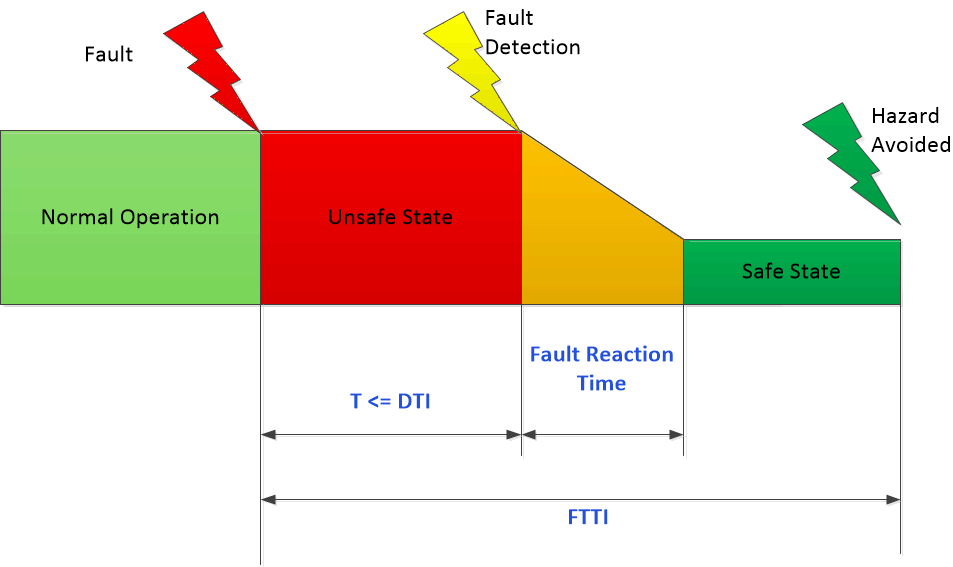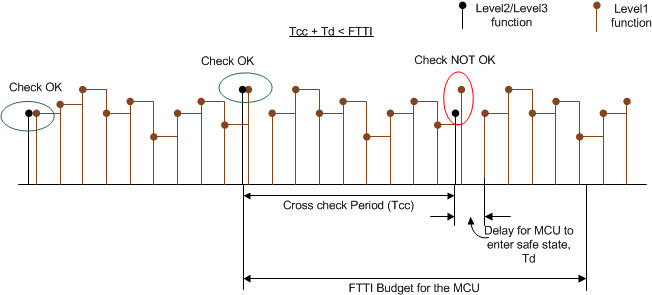SFFS022 December 2022 TMS320F28384D , TMS320F28384D-Q1 , TMS320F28384S , TMS320F28384S-Q1 , TMS320F28386D , TMS320F28386D-Q1 , TMS320F28386S , TMS320F28386S-Q1 , TMS320F28388D , TMS320F28388S
- Safety Manual for TMS320F2838xD and TMS320F2838xS
- Trademarks
- 1Introduction
- 2TMS320F2838x Product Safety Capability and Constraints
-
3TI Development Process for Management of Systematic Faults
- 3.1 TI New-Product Development Process
- 3.2 TI Functional Safety Development Process
- 3.3 C2000 Architecture and Product Overview
- 3.4
Functional Safety Concept
- 3.4.1 VDA E-GAS Monitoring Concept
- 3.4.2 TMS320F2838xD/S MCU Safety Philosophy
- 3.4.3 Fault Tolerant Time Interval (FTTI)
- 3.4.4 TMS320F2838x MCU Safe State
- 3.4.5 Assumed Safety Requirements
- 3.4.6 Operating States
- 3.4.7 Management of Faults
- 3.4.8 Suggestions for Improving Freedom From Interference
- 3.4.9 Suggestions for Addressing Common Cause Failures
- 4TMS320F2838x Diagnostics Libraries
-
5Brief Description of Safety Elements
- 5.1 C2000 MCU Infrastructure Components
- 5.2 Processing Elements
- 5.3 Memory (Flash, SRAM and ROM)
- 5.4 On-Chip Communication Including Bus-Arbitration
- 5.5
Digital I/O
- 5.5.1 General-Purpose Input/Output (GPIO) and Pin Muxing
- 5.5.2 Enhanced Pulse Width Modulators (ePWM)
- 5.5.3 High Resolution PWM (HRPWM)
- 5.5.4 Enhanced Capture (eCAP)
- 5.5.5 High Resolution Capture (HRCAP)
- 5.5.6 Enhanced Quadrature Encoder Pulse (eQEP)
- 5.5.7 Sigma Delta Filter Module (SDFM)
- 5.5.8 External Interrupt (XINT)
- 5.6 Analog I/O
- 5.7
Data Transmission
- 5.7.1 Controller Area Network (DCAN)
- 5.7.2 ECAT
- 5.7.3 Serial Peripheral Interface (SPI)
- 5.7.4 Serial Communication Interface (SCI)
- 5.7.5 Inter-Integrated Circuit (I2C)
- 5.7.6 Fast Serial Interface (FSI)
- 5.7.7 Power Management Bus Module (PMBus)
- 5.7.8 Multichannel Buffered Serial Port (McBSP)
- 5.7.9 External Memory Interface (EMIF)
- 5.8 Not Safety Related Elements
-
6Brief Description of Diagnostics
- 6.1
C2000 MCU Infrastructure Components
- 6.1.1 Clock Integrity Check Using CPU Timer
- 6.1.2 Clock Integrity Check Using HRPWM
- 6.1.3 EALLOW and MEALLOW Protection for Critical Registers
- 6.1.4 Efuse Autoload Self-Test
- 6.1.5 Efuse ECC
- 6.1.6 Efuse ECC Logic Self-Test
- 6.1.7 External Clock Monitoring via XCLKOUT
- 6.1.8 External Monitoring of Warm Reset (XRSn)
- 6.1.9 External Voltage Supervisor
- 6.1.10 External Watchdog
- 6.1.11 Glitch Filtering on Reset Pins
- 6.1.12 Hardware Disable of JTAG Port
- 6.1.13 Internal Watchdog (WD)
- 6.1.14 Lock Mechanism for Control Registers
- 6.1.15 Missing Clock Detect (MCD)
- 6.1.16 NMIWD Reset Functionality
- 6.1.17 NMIWD Shadow Registers
- 6.1.18 Multibit Enable Keys for Control Registers
- 6.1.19 Online Monitoring of Temperature
- 6.1.20 Periodic Software Read Back of Static Configuration Registers
- 6.1.21 Peripheral Clock Gating (PCLKCR)
- 6.1.22 Peripheral Soft Reset (SOFTPRES)
- 6.1.23 Software Test of Reset (Type 1)
- 6.1.24 PLL Lock Profiling Using On-Chip Timer
- 6.1.25 Reset Cause Information
- 6.1.26 Software Read Back of Written Configuration
- 6.1.27 Software Test of ERRORSTS Functionality
- 6.1.28 Software Test of Missing Clock Detect Functionality
- 6.1.29 Software Test of Reset
- 6.1.30 Software Test of Watchdog (WD) Operation
- 6.2
AUXPLL
- 6.2.1 Clock Integrity Check Using DCC
- 6.2.2 PLL Lock Indication
- 6.2.3 Internal Watchdog (WD)
- 6.2.4 Software Test of DCC Functionality Including Error Tests
- 6.2.5 External Clock Monitoring
- 6.2.6 Software Test of PLL Functionality Including Error Tests
- 6.2.7 Interleaving of FSM States
- 6.2.8 Dual Clock Comparator (DCC) – Type 1
- 6.2.9 Peripheral Access Protection - Type 0
- 6.3
Processing Elements
- 6.3.1 CLA Handling of Illegal Operation and Illegal Results
- 6.3.2 CLA Liveness Check Using CPU
- 6.3.3 CPU Hardware Built-In Self-Test (HWBIST)
- 6.3.4 CPU Hardware Built-In Self-Test (HWBIST) Auto-Coverage
- 6.3.5 CPU Hardware Built-In Self-Test (HWBIST) Fault Injection Capability
- 6.3.6 CPU Hardware Built-In Self-Test (HWBIST) Timeout Feature
- 6.3.7 CPU Handling of Illegal Operation, Illegal Results and Instruction Trapping
- 6.3.8 Reciprocal Comparison by Software
- 6.3.9 Software Test of CLA
- 6.3.10 Stack Overflow Detection
- 6.3.11 VCU CRC Check of Static Memory Contents
- 6.3.12 VCU CRC Auto Coverage
- 6.3.13 Embedded Real Time Analysis and Diagnostic (ERAD)
- 6.3.14 Inbuilt hardware redundancy in ERAD bus comparator module
- 6.3.15 Disabling of Unused CLA Task Trigger Sources
- 6.4
Memory (Flash, SRAM and ROM)
- 6.4.1 Bit Multiplexing in Flash Memory Array
- 6.4.2 Bit Multiplexing in SRAM Memory Array
- 6.4.3 Data Scrubbing to Detect/Correct Memory Errors
- 6.4.4 Flash ECC
- 6.4.5 Flash Program Verify and Erase Verify Check
- 6.4.6 Software Test of ECC Logic
- 6.4.7 Software Test of Flash Prefetch, Data Cache and Wait-States
- 6.4.8 Access Protection Mechanism for Memories
- 6.4.9 SRAM ECC
- 6.4.10 SRAM Parity
- 6.4.11 Software Test of Parity Logic
- 6.4.12 Software Test of SRAM
- 6.4.13 Memory Power-On Self-Test (MPOST)
- 6.4.14 Background CRC
- 6.4.15 Watchdog for Background CRC
- 6.4.16 Redundant Parity Engine
- 6.4.17 Test of SRAM Parity
- 6.5
On-Chip Communication Including Bus-Arbitration
- 6.5.1 1oo2 Software Voting Using Secondary Free Running Counter
- 6.5.2 DMA Overflow Interrupt
- 6.5.3 Event Timestamping Using IPC Counter
- 6.5.4 Maintaining Interrupt Handler for Unused Interrupts
- 6.5.5 Majority Voting and Error Detection of Link Pointer
- 6.5.6 PIE Double SRAM Comparison Check
- 6.5.7 PIE Double SRAM Hardware Comparison
- 6.5.8 Power-Up Pre-Operational Security Checks
- 6.5.9 Software Check of X-BAR Flag
- 6.5.10 Software Test of ePIE Operation Including Error Tests
- 6.5.11 Disabling of Unused DMA Trigger Sources
- 6.5.12 Software Test of CLB Function Including Error Tests
- 6.5.13 Monitoring of CLB by eCAP or eQEP
- 6.5.14 Lock Mechanism for Control Registers
- 6.5.15 Internal Watchdog (WD)
- 6.5.16 Periodic Software Read Back of SPI Buffer
- 6.5.17 IPC 64-Bit Counter Value Plausibility Check
- 6.6
Digital I/O
- 6.6.1 ECAP Application Level Safety Mechanism
- 6.6.2 ePWM Application Level Safety Mechanism
- 6.6.3 ePWM Fault Detection Using XBAR
- 6.6.4 ePWM Synchronization Check
- 6.6.5 eQEP Application Level Safety Mechanisms
- 6.6.6 eQEP Quadrature Watchdog
- 6.6.7 eQEP Software Test of Quadrature Watchdog Functionality
- 6.6.8 Hardware Redundancy
- 6.6.9 HRPWM Built-In Self-Check and Diagnostic Capabilities
- 6.6.10 Information Redundancy Techniques
- 6.6.11 Monitoring of ePWM by eCAP
- 6.6.12 Monitoring of ePWM by ADC
- 6.6.13 Online Monitoring of Interrupts and Events
- 6.6.14 SDFM Comparator Filter for Online Monitoring
- 6.6.15 SD Modulator Clock Fail Detection Mechanism
- 6.6.16 Software Test of Function Including Error Tests
- 6.6.17 Monitoring of HRPWM by HRCAP
- 6.6.18 HRCAP Calibration Logic Test Feature
- 6.6.19 QMA Error Detection Logic
- 6.7
Analog I/O
- 6.7.1 ADC Information Redundancy Techniques
- 6.7.2 ADC Input Signal Integrity Check
- 6.7.3 ADC Signal Quality Check by Varying Acquisition Window
- 6.7.4 CMPSS Ramp Generator Functionality Check
- 6.7.5 DAC to ADC Loopback Check
- 6.7.6 DAC to Comparator Loopback Check
- 6.7.7 Opens/Shorts Detection Circuit for ADC
- 6.7.8 VDAC Conversion by ADC
- 6.7.9 Disabling Unused Sources of SOC Inputs to ADC
- 6.8
Data Transmission
- 6.8.1 Controller Area Network (MCAN, CAN-FD)
- 6.8.2
ECAT
- 6.8.2.1 EtherCAT MDIO Command Error Indication
- 6.8.2.2 EtherCAT Sync-Manager
- 6.8.2.3 EtherCAT Working Counter Error Indication
- 6.8.2.4 EtherCAT Frame Error Indication
- 6.8.2.5 EtherCAT Physical Layer Error Indication
- 6.8.2.6 PDI Timeout Error Indication
- 6.8.2.7 EtherCAT EEPROM CRC Error Indication
- 6.8.2.8 EtherCAT EEPROM Not Done Error Indication
- 6.8.2.9 EtherCAT Data Link Error Indication
- 6.8.2.10 EtherCAT Phy Link Error Indication
- 6.8.2.11 Sync, GPO Monitoring Using External Monitor
- 6.8.2.12 EtherCAT Enhanced Link Detection With LED
- 6.8.2.13 HW Redundancy of GPIO, FMMU, Sync Manager and SYNC OUT
- 6.8.3 Bit Error Detection
- 6.8.4 CRC in Message
- 6.8.5 DCAN Acknowledge Error Detection
- 6.8.6 DCAN Form Error Detection
- 6.8.7 DCAN Stuff Error Detection
- 6.8.8 EMIF Access Latency Profiling Using On-Chip Timer
- 6.8.9 EMIF Access Protection Mechanism
- 6.8.10 EMIF Asynchronous Memory Timeout Protection Mechanism
- 6.8.11 I2C Access Latency Profiling Using On-Chip Timer
- 6.8.12 Information Redundancy Techniques Including End-to-End Safing
- 6.8.13 I2C Data Acknowledge Check
- 6.8.14 McBSP Receiver Overrun Detection
- 6.8.15 McBSP Receiver Sync Error Detection
- 6.8.16 McBSP Transmitter Sync Error Detection
- 6.8.17 McBSP Transmitter Underflow Detection
- 6.8.18 Parity in Message
- 6.8.19 SCI Break Error Detection
- 6.8.20 SCI Frame Error Detection
- 6.8.21 SCI Overrun Error Detection
- 6.8.22 Software Test of Function Using I/O Loopback
- 6.8.23 SPI Data Overrun Detection
- 6.8.24 Transmission Redundancy
- 6.8.25 FSI Data Overrun/Underrun Detection
- 6.8.26 FSI Frame Overrun Detection
- 6.8.27 FSI CRC Framing Checks
- 6.8.28 FSI ECC Framing Checks
- 6.8.29 FSI Frame Watchdog
- 6.8.30 FSI RX Ping Watchdog
- 6.8.31 FSI Tag Monitor
- 6.8.32 FSI Frame Type Error Detection
- 6.8.33 FSI End of Frame Error Detection
- 6.8.34 FSI Register Protection Mechanisms
- 6.8.35 PMBus Protocol CRC in Message
- 6.8.36 Clock Timeout
- 6.1
C2000 MCU Infrastructure Components
- 7References
- A Safety Architecture Configurations
- B Distributed Developments
- C Terms and Definitions
- D Summary of Safety Features and Diagnostics
- E Glossary
- F Revision History
3.4.3 Fault Tolerant Time Interval (FTTI)
Various safety mechanisms in the devices are either always-on (see SRAM ECC, CPU Handling of Illegal Operation, Illegal Results and Instruction Trapping, and so forth) or executed periodically (see CPU Hardware Built-In Self-Test (HWBIST), VCU CRC Check of Static Memory Contents, and so forth) by the application software. The time between the executions of online diagnostic tests by a safety mechanism is termed as Diagnostic test interval (DTI). Once the fault is detected, depending on the fault reaction of the associated fault (for example, external system reaction to ERRORSTS pin assertion), the system will enter in the safe-state. The time-span in which a fault or faults can be present in a system before a hazardous event occurs is called Fault Tolerant Time Interval (FTTI) as defined in ISO26262. This is similar to Process Safety Time (PST) defined in IEC61508. Figure 3-7 illustrates the relationship between DTI, Fault Reaction Time and FTTI.
 Figure 3-7 Relationship Between DTI, Fault Reaction Time and FTTI
Figure 3-7 Relationship Between DTI, Fault Reaction Time and FTTI Figure 3-8 Illustration of FTTI
Figure 3-8 Illustration of FTTIThe frequency and extent of each of the Level 2 and Level 3 checks should be consistent with the Fault Tolerant Time Interval (FTTI). Figure 3-8 illustrates the frequency of the required checks. The checks should be such that single point faults of the microcontroller should be detected and responded to, such that the TMS320F2838xD/S MCU enters a safe state within the FTTI budget. The microcontroller on detection of a fault enters into one of the safe states as illustrated in Figure 3-9. An example of a diagnostic for single point faults is ECC/Parity for memories.
The proposed functional safety concept, subsequent functional safety features and configurations explained in this document are for reference purpose only. The system and equipment designer or manufacturer is responsible to ensure that the end systems (and any Texas Instruments hardware or software components incorporated in the systems) meet all applicable safety, regulatory and system-level performance requirements.